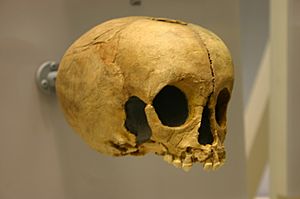Pech-de-l'Azé cave facts for kids
The Pech-de-l'Azé caves are a very old and important place in France, found in a region called Nouvelle-Aquitaine. These caves are famous because they show us how Neanderthal people lived there a long, long time ago. One of the caves, Pech-de-l'Azé I, is especially important for studying the Middle Stone Age in this area.
Contents
About the Pech-de-l'Azé Caves
These caves hold many layers of dirt and artifacts. These layers show that Neanderthals lived here on and off for thousands of years. The oldest signs of their presence are from about 80,000 to 90,000 years ago. The most recent signs are from about 35,000 years ago.
There are four main caves at this site. They are named Pech I, Pech II, Pech III, and Pech IV.
Exploring the Four Caves
Pech I: The First Discovery
Pech I was the first cave found at this site. This happened early in the 1800s. Sadly, many of the old findings were lost because people were looking for treasure. But Pech I is still famous for one big discovery. In 1909, the skull of a Neanderthal child was found here. This was a very important find for scientists!
Pech II: A Railway's Impact
The archaeologist François Bordes discovered Pech II in 1948. Part of this cave was damaged when a railway line was built in the 1800s. Even so, scientists found different layers of stone tools here. These tools showed different styles made by early humans, like those from the Acheulean and Mousterian periods.
Pech III: A Small Mystery
Pech III was found in 1951. It is a very small cave and was empty when discovered. Scientists think it might have once held layers of artifacts similar to the older parts of Pech II.
Pech IV: Ancient Fires and Unique Tools
Pech IV is perhaps the most important of the caves. François Bordes explored it in 1952. This cave has a very long record of Neanderthal life. It covers a period of about 45,000 to 55,000 years during the last Ice Age (Pleistocene epoch). The lowest layers of dirt in Pech IV contain many hearths. These are places where ancient fires were made. Finding so many hearths is rare for archaeological sites from this time in Europe.
Pech IV also has a unique collection of stone tools. These tools are called Asinipodian lithic assemblages. They are unusual because they mix very small and very large flakes (pieces chipped off stone) and cores (the main stone from which flakes are removed). This special type of Neanderthal tool kit has only been found at Pech IV.
See also
- Pech Merle - This is a different cave complex in France. It is famous for its amazing cave art.


